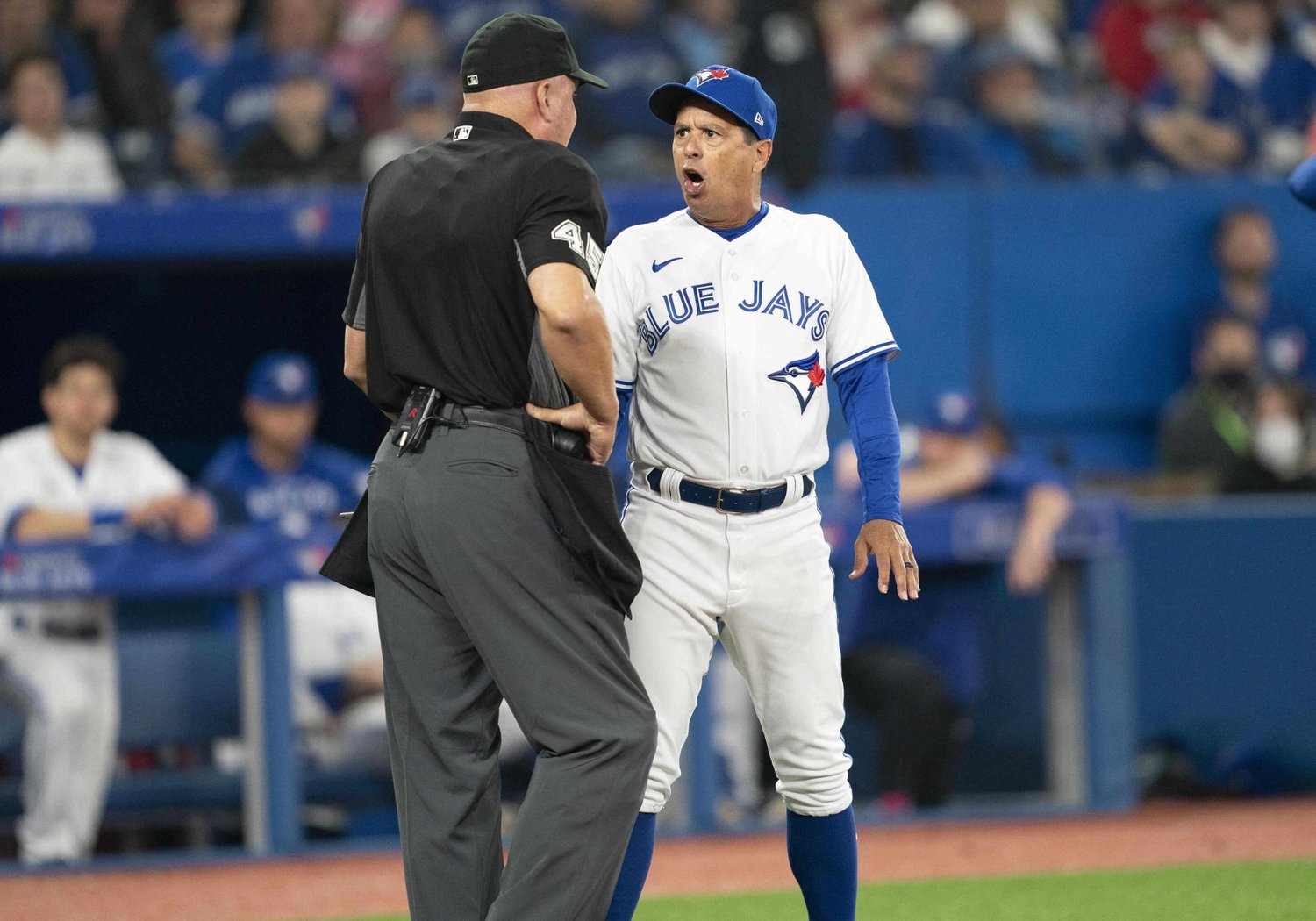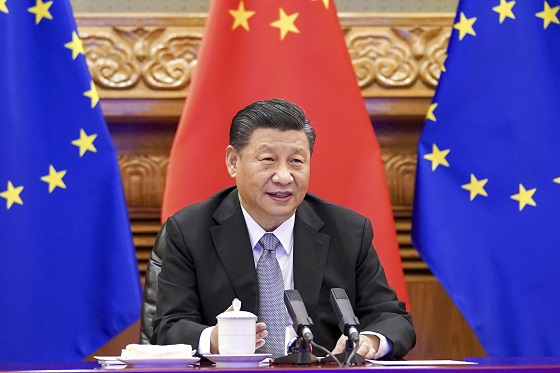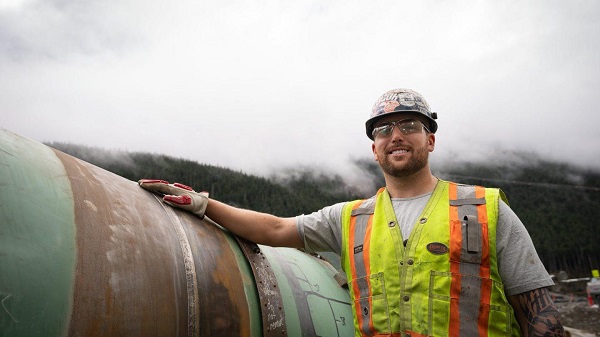Bruce Dowbiggin
MLB: Go Virtual Or Go Home

The MLB season is just two weeks old, and already baseball’s pig-headed decision not to use virtual technology to call balls/ strikes is looking like a massive blunder. While it jimmied with the DH rules and promised to use a pitch clock next season, MLB leaves the single greatest threat to the sport’s integrity unchanged.
A prime example was Saturday’s Oakland/ Toronto game where veteran umpire Jeff Nelson altered the outcome with his ball/ strike calls. According to Ump Scorecards, Nelson got just 86 percent of his calls correct. Eighteen of his 56 called strikes were actually balls. This produced +1.41 run advantage for Oakland, which won the game 7-5.
Worse, Nelson (who is rated 72nd of 74 MLB umpires) ejected Blue Jays manager Charlie Montoya for pointing out that Nelson was altering the game with his calls. His 86 percent accuracy was the worst on a day when other umps ranged from 90 to 97 percent accuracy. Run advantages ranged from Nelson’s abysmal 1.41 to 1.14 to 0.87 to 0.05.
In the past these numbers were unavailable, but with new technology and bettors looking for edges anyone can see MLB falling short. Especially when there is a clear alternative that will deliver equal results to bathe teams. As we wrote last October, the time has come to go virtual.
“There is power in sports. And then there is umpire power. As we have seen in the 2021 postseason, the ability of a single umpire behind home to shape an outcome is tremendous. That authority comes from the century before hi-tech allowed TV broadcasters to show a virtual strike zone on screen.
If the ump called it a strike, it was a strike. Despite volcanic eruptions from mangers liker Earl Weaver and generations of players blowing off steam there was no recourse. Eventually players were forced to put their bat on their shoulder and walk back to the dugout. Or to the clubhouse, if their tantrum got them tossed from the game.

Rarely was an umpire publicly fired. (Unless it was Dave Pallone who was apparently canned for being gay and upsetting Pete Rose in the days when Rose was an MLB big shot. Certainly none of them were held to any standard in terms of fitness.)
Now, however, the fan can see the virtual strike zone. And can see that an umpire like Laz Diaz, who was behind home plate for the Astros 9-2 win over the Red Sox in Game 4 of the 2021 ALCS, needs to be cashiered. This allows reporter/ author Jeff Passan to tweet:
@jeffpassan Home-plate umpire Laz Diaz has missed 21 ball-strike calls tonight, according to @ESPNStatsInfo. That is the most of any umpire this postseason. The green dot in the upper RH corner is the Eovaldi curveball that would’ve ended top of the ninth with the score 2-2.
The game was no exception for Diaz. As our friends at @umpscorecards show that Diaz missed almost ten percent of his ball/strike calls on average during the season (91.9%). One game he called only 87.6 percent of calls correctly.
Which is not to single out Diaz. For instance, Angel Hernandez missed 356 of the 4833 pitches he called this season for 92.6% accuracy. Brian O’Nora (91.8% accuracy), Jerry Meals (93%), Rob Drake (92.1%), CB Buckner (92.7%) Doug Eddings (92.6%), Larry Vanover (92.5%), Ron Kulpa (91.8%) and the legend Joe West (92.2%) are among the many who leave something to be desired. (We highly recommend following this detailed site if you are a fan or a bettor.)
While the average ball/ strike accuracy in the wider echelon of umpires hovers in the 92-95 percent range, even the best umpires have single games where their accuracy is in the mid-to-high 80s. Were those games that decided playoff spots? Division titles? Pitchers/ batters getting bonuses? Why did MLB not enforce a higher standard?
Look, 92-95 percent for the human eye in a stressful situation where 50,000 people are screaming at you is an impressive stat. And the umpiring today is scrutinized heavily by MLB for patterns that might produce betting scandals. There’s no doubt that the ball/ strike calling is vastly improved from the day when there were “pitchers’ umps” and “hitters’ umps”.
But the virtual stroke zone shows MLB can have 100 percent accuracy to a defined strike zone. Not to put @umpscorecards out of work, but with a virtual strike zone MLB has the power to remove doubt about the strike zone, end arguments and conspiracies about certain umps and make the games move faster.
One only need look at the Hawkeye system at work now in tennis for calling lines. The days of John McEnroe or Jimmy Connors going ballistic over a line call have magically ended as the computer unequivocally demonstrates that a ball is in or out. The sideshow of rage has now become a shrug of the shoulders as the affected player moves on to the next point, angry at themselves, not the chair umpire or line official.
So why doesn’t MLB use the tech they’ve got? Some suggest they’re leery of upsetting the influential umpires union who guard their privilege zealously, even in the face of some completely useless colleagues. Other still hold with the dinosaurs who say the virtual strike zone is inaccurate or can move unexpectedly.
This just in: Even if the virtual strike zone is off an inch or two it’s the same standard for both pitchers and all hitters. There’s also no need to put people out of work. The home-plate ump can still make calls on foul tips, swinging strikes, plays at the plate and the running of the game. Enough already.”
Bruce Dowbiggin @dowbboy is the editor of Not The Public Broadcaster (http://www.notthepublicbroadcaster.com). The best-selling author was nominated for the BBN Business Book award of 2020 for Personal Account with Tony Comper. A two-time winner of the Gemini Award as Canada’s top television sports broadcaster, he’s also a regular contributor to Sirius XM Canada Talks Ch. 167. His new book with his son Evan Inexact Science: The Six Most Compelling Draft Years In NHL History is now available on http://brucedowbigginbooks.ca/book-personalaccount.aspx
2025 Federal Election
How Canada’s Mainstream Media Lost the Public Trust

Breaking: CBC News admits that host Rosemary Barton was wrong on April 16 when she said “remains of indigenous children” have been discovered.
Call it the Panic Election. From The Handmaid’s Tale to Quebec alienation to plastic straws, the dynamic is citizens being stampeded in a brief six weeks by Big Brother. (There’s no Big Sister. That would mess with the narrative.) Prompting Covid Part Deux from the Laurentian media scolds.
Nowhere is this panic more keen than among aging Boomers who’ve pronounced themselves willing to ignore a decade of Justin Trudeau’s clumsy, unethical and sometimes criminal behaviour in the wake of Big Bad Trump. Even the threat of losing the country’s AAA credit rating can’t sway them from full-throated panic about being the 51st state.
The 51st state gambit is the window dressing. The real Trump panic is over him exposing the inadequacies of a Canadian society penetrated by China, dominated by globalist fanatics and more indebted every day. Specifically, Trump labelled Canadians defence dead-beats and entitled snobs who’d be crazy not to join the U.S. The insulting Trump framing has been a lifeline to those most recently in office— Liberals— to point at the Big Bad Wolf outside the door rather than the Frozen Venezuela inside its walls.
Integral to this panic is the role of Canada’s legacy media, a self-serving caste saved from bankruptcy (for now) by generous wads of public money. The 416/613 bubble ponies operate as if it were still 1985, not 2025. They’ve managed to preserve their status while society changed around them. For instance, CBC’s flagship At Issue panel features three people from Toronto and a fourth from Montreal.
It has worked perfectly in Boomer Canada. Until this past week, when the media guardians finally lost the plot. The combination of TV panel hubris and the incompetence of the Elections Commission exposed an industry more interesting in protecting its own turf than protecting the truth.
The meltdown was the notion that conservative social media— with its intrusive reporters and tabloid tactics— had no place in their sandbox. This hissy fit came after Wednesday’s French debate. Members of Rebel News, True North and other outfits dominated the party leaders’ scrums with obtrusive questions about Mark Carney’s opinions on same-sex sports and what constitutes a woman— questions the French moderator had neglected to ask.

For legacy reporters and hosts who take it as given that they be allowed the front pew this was an affront to their status. As purveyors of the one true political religion the talking heads on CBC, CTV and Global began speaking of “so-called journalists” and “far-right” intruders elbowing into their territory. Their resentment was all-consuming.
This resentment spilled into Debate Night Two when a shouting match ensued in the press room. A CBC source claimed (incorrectly) that Rebel Media leader Ezra Levant had been barred from the press room. A writer from the Hill Times screamed at members of their raucous rivals. The carefully chose panelists suggested that these outfits were funded by dark right-wing sources.
Before the debate had ended Elections Commission organizers— reportedly goaded by the Liberals— called off the post-debate scrum citing “safety” issues that seemingly included a Rebel reporter conducting a hostile walking interview with a furious Liberal official. This unleashed another torrent of Media Party vitriol about its position as the keepers of Canadian journalism.

In a show of irony, these complaints about right-wing misinformation came from people whose livelihood is dependent on Liberal slush funds or whose organizations have accepted government funds to stave off bankruptcy or whose union is an active shill for non-Conservative parties. The conflicts are never mentioned in the unctuous festival of privilege.
What makes this rearguard action against new media risible was the 2024 U.S. election where Donald Trump acknowledged the new day and rode the support of non-traditional media back to the presidency. His shunning of the legacy networks and hallowed print brands heralded a new reality in American elections. Poilievre has struggled to find this community in Canada, but for those with eyes it remains the future of disseminating political thought.
A perfect example of alternative media scooping the tenured mob on Parliament Hill has been the sterling work on China by Sam Cooper, a former Global employee who has independently demonstrated the ties between Chinese criminal gangs and the Canadian political structure going back to the 1980s. Working with others outside the grid he’s shown the scandal of a Liberal candidate urging Chinese Canadian voters to reap a bounty for turning his Conservative opponent to the Chinese Communist Party. A disgrace that Carney has forgiven.
Predictably Cooper’s work and the independent story by two retired RCMP investigators who implicated nine Liberal cabinet members in compliance with the Chinese communists has gotten the ‘tish-tish” from the Laurentian elites. Like the Democrats who buried the Hunter Biden laptop story to save his father in the dying days of the 2020 U.S. election the poodle media hope to delay the truths about China long enough to get the compliant Carney over the finish line.
For contrast to how it was— and could be— one only had to witness the moderator performance of journalist Steve Paikin of TVO. Largely unknown outside Ontario, Paikin overcame the skepticism of Westerners by playing it straight down the middle. Such was his honest-broker performance that Poilievre was heard telling him after the debate that he had no idea how Paikin might vote. (Ed. note: Paikin is a former colleague and longtime friend.) In other words, it’s still possible.
It’s a cliché that this election is a hinge point for Canada. Will it face itself in the mirror or indulge in more denialism about its true self? No wonder unaffiliated journalists joke that their stories today will be the lead on mainstream media in three months. Carney has promised to continue bribing the mainstream media, but their day is done. It’s simply a matter of fixing a date for the next panic.
Bruce Dowbiggin @dowbboy is the editor of Not The Public Broadcaster A two-time winner of the Gemini Award as Canada’s top television sports broadcaster. His new book Deal With It: The Trades That Stunned The NHL And Changed Hockey is now available on Amazon. Inexact Science: The Six Most Compelling Draft Years In NHL History, his previous book with his son Evan, was voted the seventh-best professional hockey book of all time by bookauthority.org. You can see all his books at brucedowbigginbooks.ca.
Bruce Dowbiggin
Is HNIC Ready For The Winnipeg Jets To Be Canada’s Heroes?

It’s fair to say everyone in hockey wanted the Winnipeg Jets back in the NHL. They became everyone’s darlings in 2011 when the Atlanta Thrashers, the league’s second stab at a franchise in Georgia, were sold to Canadian interests including businessman David Thomson. (Ed.: Gary Bettman’s try number three in Atlanta is upcoming.).
Yes, the market is tiny. Yes, the arena is too small. Yes, Thomson’s wealth is holding back a sea of inevitability. But sentimentalists remembering the Bobby Hull WHA Jets and the Dale Hawerchuk NHL Jets threw aside their skepticism to welcome back the Jets. The throwback uniforms with their hints at Canada’s air force past were an understated nod to their modest pretensions. It was a perfect story.

The question now, however, is will the same folks get dewey-eyed about the Jets if they become the first Canadian team to win the Stanley Cup since (checks his cards) Montreal and Patrick Roy did it in 1993. It would be helpful in this election year if something were to bind a nation torn apart by politics. The Gordie Howe Elbows Up analogy is more than shopworn, and Terry Fox can only be resurrected so often. So a Cup win might be a welcome salve.
But the approved script has long dictated that the Canadian team to break the schneid should be one of the glamour twins of the NHL’s Canadian content, the Edmonton Oilers or the (gulp) Toronto Maple Leafs. The Oilers and their superstar Connor McDavid barely lost out last spring to Florida while the Leafs, laden with superstars like Auston Matthews and William Nylander, are overdue for a long playoff run.
Hockey Night In Canada positively pants for the chance to gush over these two squads each week. When was the last time Toronto played an afternoon game so HNIC could showcase the Jets? Like, never. Same for the Oilers, who with their glittering stars like McDavid Leon Draisaitl and Ryan Nugent Hopkins are the primary tenants of the doubleheader slot, followed by Calgary. Winnipeg? We’ll get to them.

But there’s going to be no ignoring them in the spring of 2025. The Jets in the northern outpost in Manitoba were the top team in the entire league in 2024-25. They’ll comfortably win the Presidents Cup as the No. 1 squad and have home-ice advantage throughout the playoffs. They have the league’s best goalie in Connor Hellebuyck (an American) and a stable of top scorers led by Kyle Connor and Mark Schiefele. Because Winnipeg is on a lot of No Trade lists, they have built themselves through the draft and thrifty budgeting.
But will the same people who swooned over the Jets in 2011 now find them as adorable if they ruin the Stanley Cup plot lines of the Oilers, Leafs and Ottawa Senators? Will the fans of Canadian teams in Vancouver, Calgary and Montreal not making the postseason take the Jets to their hearts or will they be as phoney as the Mike Myers commercials for the Liberals?
In addition, the Jets will be swamped by national media should they proceed through the playoffs. It’s one thing to carry the expectations of Winnipeg and Manitoba. It’s another to foot the bill for a hockey crazy county. We remember Vancouver’s GM Mike Gillis during the Canucks 2011 Cup run bemoaning the late arrivers of the press trying to critique his team as they made their way through the playoffs.
It will be no picnic for the Jets, however strong they’ve been in the regular season. No one was gunning for them as they might for the Oilers or Leafs. They will now get their opponents’ best game night after night. Hellebuyck has been a top three goalie in the NHL for a while, winning the Vezina Trophy, but his playoff performance hasn’t matched that of his regular-season version.
Already the injury bug that sidelines so many Cup dreams is biting at the Jets. Nikolaj Ehlers collided with a linesman in Saturday’s OT win in Chicago. Defenceman Dylan Samberg is also questionable after stopping a McDavid slap shot with his leg. A rash of injuries has ended the run of many a worthy Cup aspirant in the past. Can Winnipeg’s depth sustain the churn of seven weeks of all-out hockey?
As always for the small-market Jets time is of the essence. Keeping this core together is difficult with large markets lusting after your players. With the NHL salary cap going up it remains a chore to keep their top players. Schiefele and Hellebuyck are tied up longterm, but 40-goal man Connor is a UFA after next season while Ehlers is not signed after this season. Young Cole Perfetti will be an RFA in 2026. Etc.
So how much do Canadians love the Jets if they sneak in and steal the hero role by winning a Canadian Cup? Lets see Ron MacLean pun his way through that one.
Bruce Dowbiggin @dowbboy is the editor of Not The Public Broadcaster A two-time winner of the Gemini Award as Canada’s top television sports broadcaster. His new book Deal With It: The Trades That Stunned The NHL And Changed Hockey is now available on Amazon. Inexact Science: The Six Most Compelling Draft Years In NHL History, his previous book with his son Evan, was voted the seventh-best professional hockey book of all time by bookauthority.org. You can see all his books at brucedowbigginbooks.ca.
-

 Business1 day ago
Business1 day agoTrump: China’s tariffs to “come down substantially” after negotiations with Xi
-

 Business1 day ago
Business1 day agoTrump considers $5K bonus for moms to increase birthrate
-

 Business2 days ago
Business2 days agoHudson’s Bay Bid Raises Red Flags Over Foreign Influence
-

 2025 Federal Election2 days ago
2025 Federal Election2 days agoMark Carney Wants You to Forget He Clearly Opposes the Development and Export of Canada’s Natural Resources
-

 2025 Federal Election2 days ago
2025 Federal Election2 days agoCanada’s pipeline builders ready to get to work
-

 Business22 hours ago
Business22 hours agoChinese firm unveils palm-based biometric ID payments, sparking fresh privacy concerns
-

 2025 Federal Election1 day ago
2025 Federal Election1 day agoPolice Associations Endorse Conservatives. Poilievre Will Shut Down Tent Cities
-

 International2 days ago
International2 days agoNew York Times publishes chilling new justification for assisted suicide




